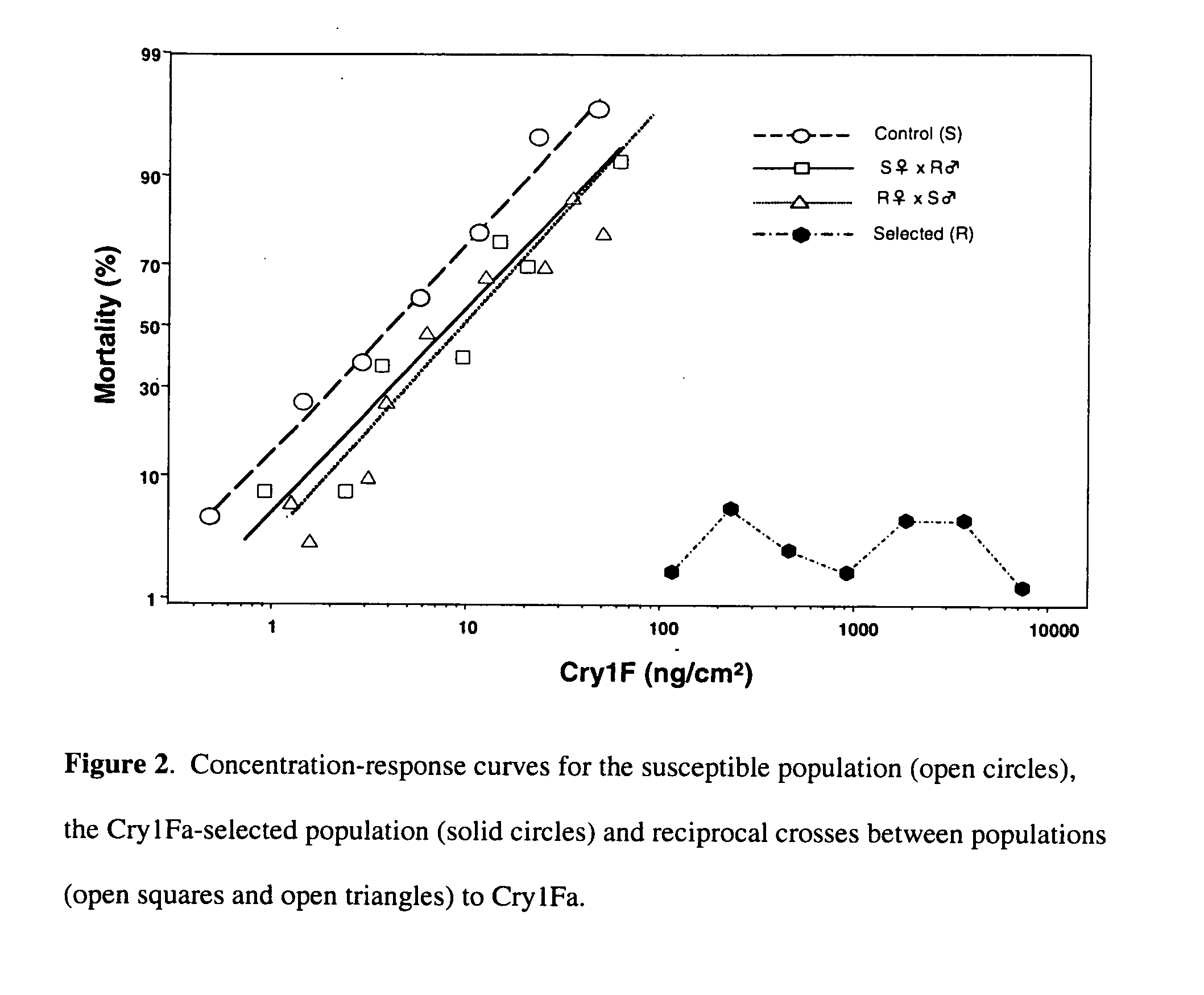Combinations of Cry1Ab and Cry1Fa as an insect resistance management tool
a technology of insect resistance and conjugation, which is applied in the direction of biocide, peptides, genetic material ingredients, etc., to achieve the effect of preventing or delaying the development of resistan
- Summary
- Abstract
- Description
- Claims
- Application Information
AI Technical Summary
Benefits of technology
Problems solved by technology
Method used
Image
Examples
example 1
[0047]An O. nubilalis population that was approximately 1200× resistant to Cry1F was created via a laboratory selection program. Larvae from this Cry1F-resistant population and the corresponding non-selected (i.e., Cry1F sensitive) population were assessed for their ability to survive on plant tissue from near-isogenic corn genotypes expressing Cry1F, Cry1Ab or no insecticidal protein (i.e., non-transgenic).
[0048]Bioassays were conducted on sections of leaves from each corn genotype using neonate O. nubilalis. Leaf sections approximately 2 cm in area were placed in each well of a 32 well plastic tray containing solidified agar / water. Each leaf section was infested with 50-60 neonate O. nubilalis. The trays were sealed with a ventilated mylar lid and held at 26° C. for 3 days. After 3 days, larval feeding on the leaf sections was assessed using the rating system summarized in Table 1. Leaves from approximately 50 plants of each genotype were bioassayed in this experiment.
TABLE 1Ratin...
example 2
[0050]The O. nubilalis population of Example 1 was further characterized in laboratory studies. These studies were designed to (1) quantify the level of resistance to Cry1Fa relative to a susceptible laboratory population, (2) identify potential cross-resistance to Cry1Ab, and (3) determine the genetic basis of resistance (i.e., monogenic vs. polygenic, autosomal vs. sex-linked).
[0051]The Cry1Fa-selected colony described in Example 1 was maintained by exposing neonate larvae to a concentration of Cry1Fa that corresponded to the upper limit of the 95% confidence interval of the LC99 derived from assessments of Cry1Fa-susceptible field populations. Individual neonate larvae (at least 1,000 per generation) were exposed to artificial diet in which the diet surface was treated with Cry1Fa. Surviving larvae (those that had initiated feeding and grown beyond first instar) were transferred to untreated diet and reared to adults using standard rearing techniques. A Cry1Fa susceptible colony ...
PUM
| Property | Measurement | Unit |
|---|---|---|
| height | aaaaa | aaaaa |
| resistance | aaaaa | aaaaa |
| insect resistance traits | aaaaa | aaaaa |
Abstract
Description
Claims
Application Information
 Login to View More
Login to View More - R&D
- Intellectual Property
- Life Sciences
- Materials
- Tech Scout
- Unparalleled Data Quality
- Higher Quality Content
- 60% Fewer Hallucinations
Browse by: Latest US Patents, China's latest patents, Technical Efficacy Thesaurus, Application Domain, Technology Topic, Popular Technical Reports.
© 2025 PatSnap. All rights reserved.Legal|Privacy policy|Modern Slavery Act Transparency Statement|Sitemap|About US| Contact US: help@patsnap.com


